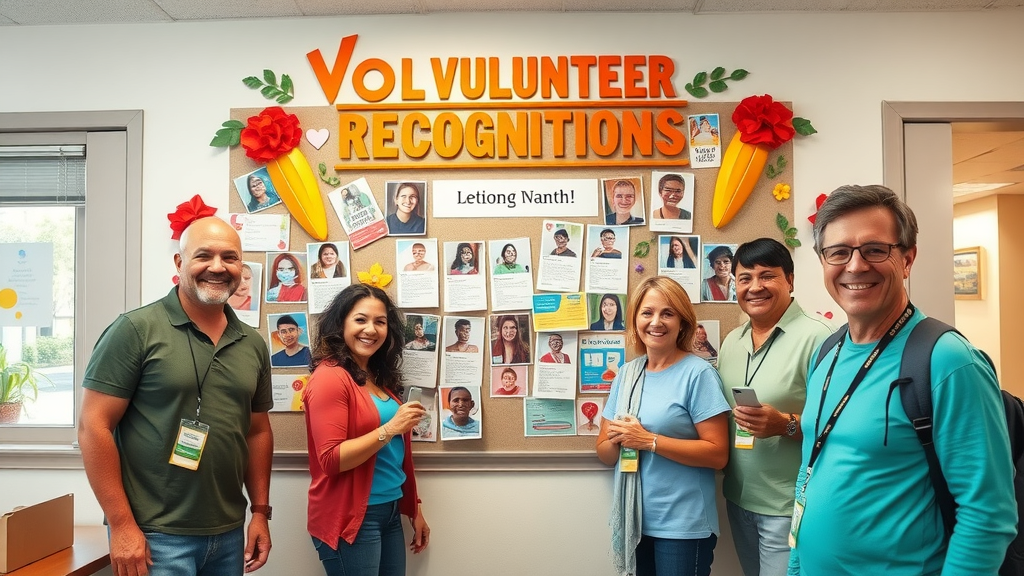Introduction: The Untapped Potential of Volunteer Recognition and Rewards
Did you know that over 60% of volunteers say they would increase their commitment if they felt more recognized? Volunteer recognition and rewards aren’t just “nice to have”—they’re a secret ingredient in maintaining and growing an engaged, loyal volunteer base. In the world of nonprofits, where every minute and resource counts, knowing how to effectively appreciate your volunteers can mean the difference between a thriving program and one struggling with retention. This article reveals the essential strategies, best practices, and innovative tools successful organizations use to make their volunteers feel truly valued. Whether you’re launching a new volunteer recognition program or refreshing your volunteer appreciation ideas, these secrets will help you create a culture where volunteers are eager to return and put forth their best effort.

"Over 60% of volunteers say they would increase their commitment if they felt more recognized."
What You'll Learn About Volunteer Recognition and Rewards
- Understand proven strategies for volunteer appreciation
- Explore effective volunteer reward and recognition programs
- Learn how volunteer management apps can streamline volunteer engagement
- Discover actionable steps for recognizing volunteers formally and informally
- See examples of high-impact volunteer appreciation ideas
The Foundations: Why Volunteer Recognition and Rewards Matter
How Volunteer Appreciation Drives Engagement
Volunteer recognition and rewards are more than just gestures—they are essential to keeping your volunteers engaged and eager to return. Numerous studies and successful organizations agree: when you thank your volunteers for their hard work and make them feel appreciated, volunteer retention and participation skyrocket. Recognition meets an innate human desire to feel valued. It turns occasional involvement into sustained commitment, and makes the volunteer program a source of pride for the wider community. Using thoughtful appreciation event planning or frequent acknowledgments via digital channels can directly improve volunteer engagement, motivate longer volunteer shifts, and encourage peer recruitment.
Interestingly, a well-structured recognition program increases not only commitment but builds lasting relationships between volunteers and organizations. Offering rewards—from a gift card sourced from local businesses to the spotlighting of volunteer contributions on social media—demonstrates that you recognize volunteers as important partners, not just labor. When volunteers feel that their contributions are seen and celebrated, they become brand ambassadors for your cause, fueling organic growth and making your nonprofit more resilient against volunteer drop-off.

Volunteer Recognition and Organization Culture
Organizations with an embedded culture of volunteer recognition stand out. Consistent appreciation signals to both existing and prospective volunteers that the organization values its people and celebrates their impact. This drives a positive feedback loop: as volunteers feel more attached through appreciation, they, in turn, participate more fully and offer constructive feedback, making the entire volunteer management process more robust.
High-impact organizations don’t rely solely on once-a-year appreciation ideas or rigid recognition programs. Instead, they blend formal volunteer acknowledgement (like annual awards) with informal, frequent reminders that each person matters. This integration sustainably strengthens the fabric of volunteer engagement, countering burnout and increasing volunteer reward for all involved—both the giver and the organization itself.
| Recognition Strategy | Impact on Retention | Impact on Engagement |
|---|---|---|
| Annual Appreciation Events | Medium | High |
| Ongoing Digital Recognition (social media, apps) | High | Medium |
| Gift Cards and Tangible Rewards | Highest | High |
Essential Elements of Effective Volunteer Recognition and Rewards

Formal Versus Informal Volunteer Recognition
There are two main types of recognition: formal and informal. Formal volunteer recognition includes planned events—such as an annual volunteer appreciation event, award ceremonies, or structured reward and recognition programs. These formal practices are excellent for public acknowledgment and can cement an individual volunteer’s sense of achievement. However, impactful organizations realize that informal recognition (like personalized thank-you notes, spontaneous social media shoutouts, or a quick message on a volunteer app) can be just as meaningful as major events. In fact, the best programs blend formal and informal approaches, delivering consistency and spontaneity, ensuring every volunteer feels appreciated in real time.
"Recognition doesn’t have to be grand; it just has to be genuine."
A mix of both forms ensures that hard work is noticed as it happens, and that major milestones are celebrated on a larger scale. By integrating formal volunteer recognition with everyday gestures of gratitude, you make sure no volunteer’s contribution goes unnoticed. This balanced approach is a cornerstone of successful volunteer recognition program development.
Building Inclusive Volunteer Recognition Programs
Inclusion is a critical component when designing your volunteer reward and recognition strategies. Volunteers join organizations for many reasons, from gaining work experience to contributing to a cause they care about. Naturally, rewards and appreciation ideas should be just as diverse. Offering a range of options—from public accolades during an appreciation event, to quiet personalized tokens for those who prefer privacy—makes all volunteers feel valued.
Inclusivity also means recognizing the different ways volunteers contribute. Someone may not work the longest volunteer shift but may provide invaluable expertise or build connections with local businesses. Tailoring your recognition program to acknowledge unique contributions ensures everyone feels appreciated, reinforcing a culture where volunteers feel safe, respected, and motivated to bring their best.

Utilizing Volunteer Apps for Recognition and Rewards
Modern volunteer recognition programs increasingly leverage technology. A volunteer app can automate thank-you messages after volunteer shifts, enable peer-to-peer recognition, and offer digital reward points redeemable for a gift card or digital badge. Efficient volunteer management apps also streamline the process of nominating volunteers for recognition programs, tracking contributions, and sending reminders for key appreciation events. Combining tech solutions with personal appreciation ensures your program is not only high-impact but also scalable and trackable, giving you valuable data on what makes your volunteers feel appreciated.
Additionally, a volunteer app makes it easier to integrate social media shoutouts and share volunteer milestones publically. This digital approach increases visibility for your volunteers, encourages others to join, and creates an ecosystem where positive recognition is a regular part of the volunteer journey.
How to Recognize Volunteers: Techniques and Approaches

Volunteer Appreciation Event Planning
Planning a memorable appreciation event is a powerful way to show volunteers how much their commitment means to the organization. Consider your volunteers’ unique preferences—some may appreciate a formal banquet, while others might enjoy a fun, casual barbecue or virtual trivia event. These events are best when they highlight individual volunteer stories, celebrate milestones, and offer tangible rewards, such as plaques, certificates, or a gift card provided by local businesses. The most successful appreciation events are interactive and inclusive, inviting volunteers to share their experiences and contribute ideas for future recognition.
Think beyond the once-a-year model! Frequent informal gatherings or monthly recognition lunches can also make an impact. The goal is to dive beyond one-size-fits-all and create opportunities that make your volunteers feel seen for their hard work—whether they serve weekly or just for a single volunteer shift. Remember, giving volunteers a platform to reflect encourages long-term engagement and deeper connections with your mission.
Leveraging Social Media to Publicly Recognize Volunteers
Public acknowledgment via social media is one of the fastest, most effective ways to make volunteers feel valued. Share pictures, anecdotes, and quotes about your volunteers across channels like Facebook, Instagram, and LinkedIn. Tagging volunteers—the new digital “thank you”—not only highlights individual contributions, but also increases the visibility of your volunteer program, attracting future supporters. Social media posts can be informal, like a friendly shoutout after a successful event, or formal, like showcasing “Volunteer of the Month” stories.
Social media recognition amplifies your appreciation beyond the organization’s walls. It lets friends, family, and the wider community see and celebrate the difference volunteers make. This digital spotlight can be more meaningful to some than a physical reward, fostering a reputation that your program genuinely values every volunteer. Integrating social media into your overall recognition program is a must for modern volunteer management.
Gift Cards, Certificates, and Tangible Volunteer Rewards
Tangible rewards continue to be powerful tokens of appreciation for volunteers. Gift cards—from coffee shops, bookstores, or local restaurants—are versatile, universally appreciated gestures. Custom certificates, collectible pins, or branded organizational gear further reinforce belonging and pride. Don’t forget the personal touch: a handwritten thank-you note or a certificate detailing an individual volunteer’s unique impact makes all the difference.
When you give volunteers these tokens, focus on personalization whenever possible. Recognize the volunteer’s specific role (not just “great job!”), highlight their hard work, and ensure rewards reflect what makes them feel appreciated. Engaging local businesses to sponsor rewards can stretch your budget and create deeper ties to your community.
- Gift card ideas for diverse volunteers
- Personalized thank-you notes
- Custom certificates and pins
Structuring a Volunteer Recognition Program: Step-by-Step Guide
- Assessing volunteer contributions
- Selecting recognition program types
- Incorporating volunteer management software
- Promotion and communication strategies
- Measuring impact and feedback
Building a volunteer recognition program from the ground up may seem daunting, but breaking it into simple steps helps you create a sustainable solution. Start by assessing volunteer contributions with the help of digital tools or a volunteer app—track hours, special projects, and impact made. Next, determine the right recognition mix: formal volunteer appreciation events, informal social media mentions, and tiered rewards. Technology plays a crucial role, so incorporate management platforms that simplify scheduling, recordkeeping, and automate key recognition touchpoints. Communicating your program widely increases buy-in, while ongoing measurement and feedback ensure you keep improving your recognition strategies.
Watch our exclusive interview compilation, where nonprofit leaders share their real-world volunteer recognition strategies, revealing what works, how to adapt ideas to your organization, and the real results achieved.
Innovative Volunteer Appreciation Ideas for Lasting Engagement

- Peer-to-peer recognition highlights
- Micro-volunteering rewards
- Exclusive training or experience days
Creative approaches keep volunteer engagement high. Try setting up a recognition wall where volunteers post their successes or shout out peers for their hard work—a physical or digital version. Start a peer-to-peer program that lets volunteers celebrate each other’s contributions, deepening team bonds. Micro-volunteering rewards (such as digital badges for quick projects) and exclusive opportunities (like leadership training or a “behind-the-scenes” day) provide ongoing motivation. What matters is communicating that you value every level of involvement and giving volunteers choices for how they’d like to be appreciated.
Best Practices: Volunteer Management for High-Impact Recognition
"A well-run volunteer recognition program is just as important as recruitment."
Tracking Volunteer Engagement with Apps

Modern volunteer management hinges on smart use of technology. Volunteer management apps let you automate hour-tracking, instantly send thank-you messages, and organize all aspects of your recognition program. With real-time data at your fingertips, you can identify your most engaged volunteers, spot trends, and tailor appreciation accordingly. Integrating apps with social media makes sharing recognition effortless, leading to higher volunteer satisfaction and improved program outcomes.
Remember, what gets measured gets managed. Continuously track volunteer engagement, reward distribution, and feedback so you consistently refine your strategies. The right app ensures that recognizing volunteers is never overlooked, freeing your team up to focus on mission delivery.
Hear directly from volunteers and managers about the powerful impact of everyday recognition and what truly makes them feel valued and motivated to return.
People Also Ask: How to reward and recognize volunteers?
Rewarding and Recognizing Volunteers: Strategies and Examples
There are countless ways to reward and recognize volunteers—all grounded in making them feel valued for their unique contributions. Formal programs might include annual appreciation events, awards, or gift cards. Informal methods include daily “thank you” emails, handwritten notes, spotlighting volunteer achievements on social media, or using a volunteer app to send digital badges. The most effective organizations blend both, regularly looking for fresh appreciation ideas and involving volunteers in the design of their own recognition programs.
Small, consistent gestures often matter most. Letting a volunteer know you saw their effort, even if it was just picking up supplies after a volunteer shift, goes a long way. The ultimate goal is to create a recognition-rich culture where everyone feels their hard work matters.
People Also Ask: What are the rewards of volunteering?
The Mutual Rewards: Volunteer Benefits and Organizational Value
While volunteers often serve without expectation of tangible reward, the act of volunteering delivers real benefits for both the individual and the organization. Volunteers gain new skills, meaningful connections, and a sense of purpose. Organizations benefit from their diverse expertise, expanded capacity, and enhanced credibility with the public. When you make volunteers feel appreciated and ensure your volunteer recognition program is robust, these mutual rewards multiply, increasing both retention and impact.
From heartfelt friendships to personal growth, and from organizational success to community transformation, the rewards of volunteering—when coupled with high-quality volunteer recognition and rewards—are truly priceless.
People Also Ask: What to say to volunteers for recognition?
Powerful Phrases and Messages for Thanking Your Volunteers
Words matter. Whether at an appreciation event, on social media, or in a quick one-on-one conversation, use specific, personal language to recognize volunteers. Instead of a generic “thank you,” name the task and describe its impact—“Your hard work organizing the event made everything run smoothly and inspired others to join us.” Let volunteers know you see and value their unique contributions. Incorporating phrases like, “We couldn’t have done it without you,” or “Your commitment is changing lives,” makes the gratitude authentic.
Never underestimate the power of a personal thank-you note or a spontaneous public acknowledgment. Frequent, specific praise is the most effective way to make your volunteers feel truly appreciated.
People Also Ask: What award do you get for volunteering?
Volunteer Award Types and How to Present Them
Awards for volunteers range from certificates of appreciation and service pins to personalized trophies and digital badges delivered via a volunteer app. Gift cards for exemplary service, “Volunteer of the Month” plaques, or a thank-you video montage are all effective and cherished. The key is to match the award to the volunteer’s preferences and contribution: public for those who love the spotlight, private for those who value quiet acknowledgment.
When presenting awards, make it personal and sincere. Detail what the volunteer achieved, and how their actions supported the organization’s mission. Whether at a large event or a one-on-one meeting, meaningful awards make volunteers feel recognized and proud of their service.
FAQs: Volunteer Recognition and Rewards
-
How often should volunteers be recognized?
Volunteers should be recognized consistently throughout the year. Monthly acknowledgments, plus timely informal gestures and an annual appreciation event, keep them engaged and motivated. -
Should recognition be public or private?
Both public and private recognition are important. Public recognition (like social media shoutouts) boosts morale and visibility, while private, personalized thank-yous can provide deep, individual affirmation. -
Can digital tools help in volunteer appreciation?
Absolutely! Volunteer apps streamline recognition, track engagement, and automate thank-yous, making ongoing appreciation simple and data-driven. -
What if budget is limited for rewards?
Low-cost options—like handwritten notes, social media shoutouts, peer recognition programs, and digital certificates—can be highly meaningful and impactful when done sincerely.
Quotes from Volunteer Leaders on Recognition and Rewards
"Volunteers don’t just want thanks, they want to feel their contribution matters." – Nonprofit Director
Key Takeaways: Implementing Volunteer Recognition and Rewards
- Recognition programs increase volunteer retention and satisfaction
- Personal touches make appreciation more genuine
- Leadership involvement amplifies recognition impact
- Diversity in rewards meets all volunteer needs
Conclusion: Making Volunteer Recognition and Rewards a Priority
Effective volunteer recognition and rewards drive engagement, satisfaction, and long-term success for both volunteers and organizations. Make recognition an ongoing priority—your volunteers, and your mission, will thrive.
Ready to Optimize Your Volunteer Recognition and Rewards? Call me the Chaplain 786-333-5270
To deepen your understanding of effective volunteer recognition and rewards, consider exploring the following resources:
-
“9 Volunteer Appreciation Gift Ideas”: This article offers a variety of thoughtful gift ideas, such as professional development opportunities and prepaid cards, to show appreciation for volunteers. (tremendous.com)
-
“Top 10 Volunteer Appreciation Ideas to Grow Your Nonprofit”: This piece provides creative strategies, including creating a volunteer recognition wall and leveraging social media, to enhance volunteer engagement and retention. (goldenvolunteer.com)
These resources offer practical insights and innovative ideas to help you develop a robust volunteer recognition program that fosters engagement and loyalty.
 Add Row
Add Row  Add
Add 




Write A Comment